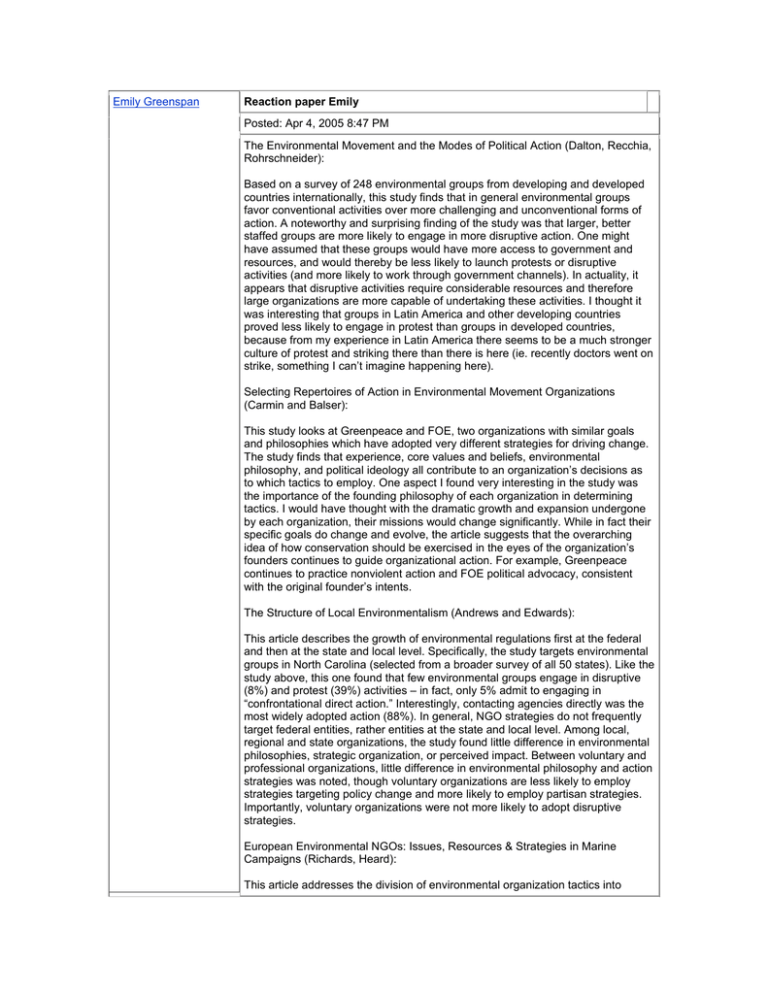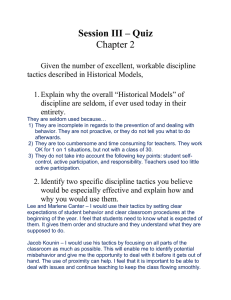Emily Greenspan Reaction paper Emily Posted: Apr 4, 2005 8:47 PM
advertisement

Emily Greenspan Reaction paper Emily Posted: Apr 4, 2005 8:47 PM The Environmental Movement and the Modes of Political Action (Dalton, Recchia, Rohrschneider): Based on a survey of 248 environmental groups from developing and developed countries internationally, this study finds that in general environmental groups favor conventional activities over more challenging and unconventional forms of action. A noteworthy and surprising finding of the study was that larger, better staffed groups are more likely to engage in more disruptive action. One might have assumed that these groups would have more access to government and resources, and would thereby be less likely to launch protests or disruptive activities (and more likely to work through government channels). In actuality, it appears that disruptive activities require considerable resources and therefore large organizations are more capable of undertaking these activities. I thought it was interesting that groups in Latin America and other developing countries proved less likely to engage in protest than groups in developed countries, because from my experience in Latin America there seems to be a much stronger culture of protest and striking there than there is here (ie. recently doctors went on strike, something I can’t imagine happening here). Selecting Repertoires of Action in Environmental Movement Organizations (Carmin and Balser): This study looks at Greenpeace and FOE, two organizations with similar goals and philosophies which have adopted very different strategies for driving change. The study finds that experience, core values and beliefs, environmental philosophy, and political ideology all contribute to an organization’s decisions as to which tactics to employ. One aspect I found very interesting in the study was the importance of the founding philosophy of each organization in determining tactics. I would have thought with the dramatic growth and expansion undergone by each organization, their missions would change significantly. While in fact their specific goals do change and evolve, the article suggests that the overarching idea of how conservation should be exercised in the eyes of the organization’s founders continues to guide organizational action. For example, Greenpeace continues to practice nonviolent action and FOE political advocacy, consistent with the original founder’s intents. The Structure of Local Environmentalism (Andrews and Edwards): This article describes the growth of environmental regulations first at the federal and then at the state and local level. Specifically, the study targets environmental groups in North Carolina (selected from a broader survey of all 50 states). Like the study above, this one found that few environmental groups engage in disruptive (8%) and protest (39%) activities – in fact, only 5% admit to engaging in “confrontational direct action.” Interestingly, contacting agencies directly was the most widely adopted action (88%). In general, NGO strategies do not frequently target federal entities, rather entities at the state and local level. Among local, regional and state organizations, the study found little difference in environmental philosophies, strategic organization, or perceived impact. Between voluntary and professional organizations, little difference in environmental philosophy and action strategies was noted, though voluntary organizations are less likely to employ strategies targeting policy change and more likely to employ partisan strategies. Importantly, voluntary organizations were not more likely to adopt disruptive strategies. European Environmental NGOs: Issues, Resources & Strategies in Marine Campaigns (Richards, Heard): This article addresses the division of environmental organization tactics into insider/outsider (insider tactics take advantage of connections to government officials and outsider tactics attempt to drive change from outside of government). The article claims that organizations often use a combination of each and that assuming that certain types of organizations adopt one type of tactic and not the other is an oversimplification. The findings are based on information gathered through interviews and questionnaires of marine ENGOs in 32 European countries. The study also found that these NGOs prefer media and policy tactics and least favor legal tactics (which are seen as riskier due to financial and resource costs and limited press exposure). One very interesting note was that “several respondents indicated that they were considering engaging in more confrontational approaches, as traditional tactics had failed to achieve satisfactory results” (33). This suggests that the trend noted in the articles described above (a lack of interest among environmental groups in unconventional/protest activities) might be changing.




